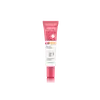What's inside
What's inside
 Key Ingredients
Key Ingredients

 Benefits
Benefits

 Concerns
Concerns

 Ingredients Side-by-side
Ingredients Side-by-side

Water
Skin ConditioningButylene Glycol
HumectantButyl Methoxydibenzoylmethane
UV AbsorberEthylhexyl Methoxycinnamate
UV AbsorberGlycerin
HumectantPhenylbenzimidazole Sulfonic Acid
UV AbsorberOctocrylene
UV AbsorberPolyacrylate Crosspolymer-11
Emulsion StabilisingBetaine
HumectantCentella Asiatica Extract
CleansingTriethanolamine
BufferingSilica
AbrasivePhenoxyethanol
PreservativeCamellia Sinensis Leaf Extract
AntimicrobialLecithin
EmollientChlorphenesin
AntimicrobialTriethylene Glycol
MaskingMethicone
EmollientWater, Butylene Glycol, Butyl Methoxydibenzoylmethane, Ethylhexyl Methoxycinnamate, Glycerin, Phenylbenzimidazole Sulfonic Acid, Octocrylene, Polyacrylate Crosspolymer-11, Betaine, Centella Asiatica Extract, Triethanolamine, Silica, Phenoxyethanol, Camellia Sinensis Leaf Extract, Lecithin, Chlorphenesin, Triethylene Glycol, Methicone
1,2-Hexanediol
Skin ConditioningWater
Skin ConditioningArtemisia Capillaris Flower Extract
Skin ConditioningBifida Ferment Lysate
Skin ConditioningBiosaccharide Gum-1
HumectantBisabolol
MaskingButyloctyl Salicylate
Skin ConditioningCaprylhydroxamic Acid
Caprylyl Methicone
Skin ConditioningCetyl PEG/PPG-10/1 Dimethicone
EmulsifyingCitric Acid
BufferingCyclopentasiloxane
EmollientDimethicone
EmollientDisteardimonium Hectorite
StabilisingHexyl Laurate
EmollientMineral Salts
Skin ConditioningPhenoxyethanol
PreservativePolyglyceryl-4 Isostearate
EmulsifyingPolymethyl Methacrylate
Pongamol
MaskingPropanediol
SolventPropylene Carbonate
SolventSaccharide Isomerate
HumectantSilica
AbrasiveSodium Chloride
MaskingSodium Citrate
BufferingSorbitan Olivate
EmulsifyingTetrasodium EDTA
Titanium Dioxide
Cosmetic ColorantTriethoxycaprylylsilane
Zinc Oxide
Cosmetic Colorant1,2-Hexanediol, Water, Artemisia Capillaris Flower Extract, Bifida Ferment Lysate, Biosaccharide Gum-1, Bisabolol, Butyloctyl Salicylate, Caprylhydroxamic Acid, Caprylyl Methicone, Cetyl PEG/PPG-10/1 Dimethicone, Citric Acid, Cyclopentasiloxane, Dimethicone, Disteardimonium Hectorite, Hexyl Laurate, Mineral Salts, Phenoxyethanol, Polyglyceryl-4 Isostearate, Polymethyl Methacrylate, Pongamol, Propanediol, Propylene Carbonate, Saccharide Isomerate, Silica, Sodium Chloride, Sodium Citrate, Sorbitan Olivate, Tetrasodium EDTA, Titanium Dioxide, Triethoxycaprylylsilane, Zinc Oxide
 Reviews
Reviews

Ingredients Explained
These ingredients are found in both products.
Ingredients higher up in an ingredient list are typically present in a larger amount.
Phenoxyethanol is a preservative that has germicide, antimicrobial, and aromatic properties. Studies show that phenoxyethanol can prevent microbial growth. By itself, it has a scent that is similar to that of a rose.
It's often used in formulations along with Caprylyl Glycol to preserve the shelf life of products.
Silica, also known as silicon dioxide, is a naturally occurring mineral. It is used as a fine, spherical, and porous powder in cosmetics.
Though it has exfoliant properties, the function of silica varies depending on the product.
The unique structure of silica enhances the spreadability and adds smoothness, making it a great texture enhancer.
It is also used as an active carrier, emulsifier, and mattifier due to its ability to absorb excess oil.
In some products, tiny microneedles called spicules are made from silica or hydrolyzed sponge. When you rub them in, they lightly polish away dead skin layers and enhance the penetration of active ingredients.
Learn more about SilicaWater. It's the most common cosmetic ingredient of all. You'll usually see it at the top of ingredient lists, meaning that it makes up the largest part of the product.
So why is it so popular? Water most often acts as a solvent - this means that it helps dissolve other ingredients into the formulation.
You'll also recognize water as that liquid we all need to stay alive. If you see this, drink a glass of water. Stay hydrated!
Learn more about Water